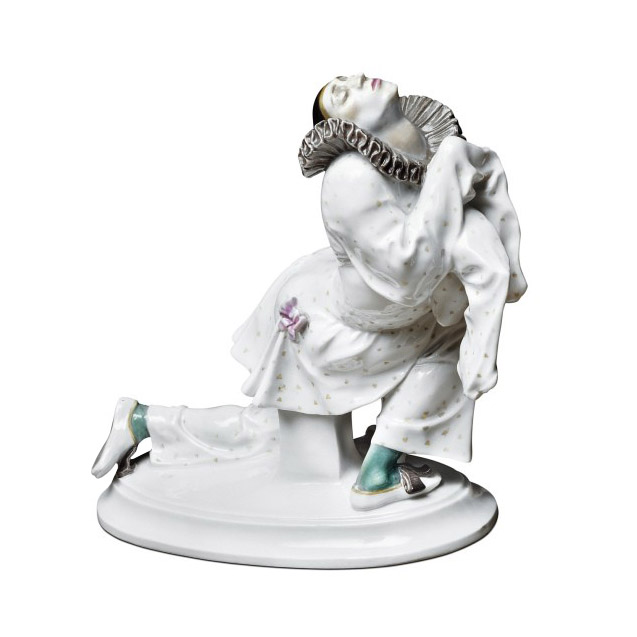Pierrot
 Sculptor: Paul Scheurich
Sculptor: Paul Scheurich
Year of creation: 1913
Height: 18 cm
Limited edition: 10 per year
Pierrot is one of the figures from Paul Scheurich’s collection dedicated to Diaghilev's "Ballets Russes". The sculptor took the "Carnival" composition of Mikhail Fokin as the basis for his own creation. The clever, quirky but often eccentric Pedrolino from the Italian Commedia dell'arte actually served as a prototype for Pierrot. In the early 19th century, the French redefined the image of Pedrolino and created Pierrot, the image of an unfortunate rejected lover, of an unfortunate companion and of the rival of Harlequin. He was an emotionally thin and extremely vulnerable character. The person playing the character of Pierrot always performed unmasked. It is believed that the servant Pierrot used to be a miller before, who was dressed white clothes and who always had flour in his face and painted tears. Therefore, he did not need a mask. The traditional clothing for Pierrot was a white free shirt with long sleeves, a round ribbed collar and a cap. Sometimes he had huge pockets in which he kept romantic souvenirs. He is sentimental, amorous, trusting and committed to his boss. He is constantly suffering from his unrequited love for Columbine and from being ridiculed by the other characters. It is interesting why his sleeves are so long and the other characters’ costumes are tight and narrow. There is, however, no unequivocal answer to this question. According to one version, the costume of Pierrot reflected the trend of modern fashion at that time and on to this day his costume was not changed. It is known that long sleeves were very much a whim of fashion in that period. As a rule, in the Middle Ages, people wore broad tunics with wide hanging sleeves to the floor, which did not have any particular functional significance. Initially, these sleeves were sewn and were removable, and one was supposed to have several sets of sleeves for each dress. On knightly tournaments ladies could even give their sleeves as a sign of honor to the knight, who in turn would attach them to his shield as a symbol of devotion before rushing into battle. Most likely these long sleeves merged with the image of Pierrot and became an attribute which visually emphasized its absurdity, the constant depression, sadness, and grief. He was always depicted with low shoulders and sleeves hanging down to the ground, further aggravating the image of sadness and despair. It is as if sleeves were becoming the symbol of man who puts his hands down out of despair. The Pierrot figure of Scheurich is displayed in an almost praying posture. Pierrot bent his left knee, strongly putting his legs inwards in a completely hypertrophic manner. It looks as if the body of Pierrot lies on one knee, put forward, as if he is afraid of falling from weakness. All parts of his body are located towards the inside, his shoulders raised and his hands pressed against his chest. The sculptor decorated Pierrot’s costume with delicate pink bows, thus emphasizing the tenderness of this character. His face was drawn up, frozen in an expression of peace and humility, his eyes covered. His cap fell on the floor, and the sleeves as hanging down helplessly as always. In "Carnival", he contrasted the joyful Harlequin and the intrigante Columbine. In order to fully experience the carnival atmosphere, we encourage you to consult the complete collection of the Russian Ballet, presented in our online store " Art Salon".


